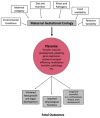Placental-Heart Axis: An Evolutionary Perspective
- PMID: 39456993
- PMCID: PMC11508449
- DOI: 10.3390/ijms252011212
Placental-Heart Axis: An Evolutionary Perspective
Abstract
To maintain its development, the growing fetus is directly dependent on the placenta, an organ that acts as both a modulator and mediator. As an essential component of pregnancy that is derived from both maternal and fetal tissues, the placenta facilitates the passage of all oxygen and nutrients from the expecting parent to their fetuses. Further, the placenta conveys multiple impacts of the maternal environment to the growing fetus. The timing of placental development parallels that of the fetal cardiovascular system, and placental anomalies are implicated as a potential cause of congenital heart disease. For example, congenital heart disease is more common in pregnancies complicated by maternal preeclampsia, a condition characterized by placental dysfunction. Given the placenta's intermediary links to the maternal environment and fetal health outcomes, it is an emerging focus of evolutionary medicine, which seeks to understand how interactions between humans and the environment affect our biology and give rise to disease. The present review provides an overview of the evolutionary and developmental courses of the placenta as well as their implications on infant health.
Keywords: congenital heart disease; evolutionary biology; placenta.
Conflict of interest statement
The authors declare no conflicts of interest.
Figures





References
Publication types
MeSH terms
Grants and funding
LinkOut - more resources
Full Text Sources
Research Materials

